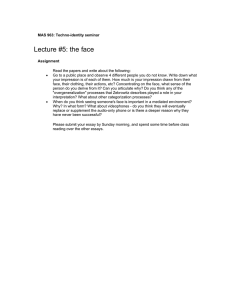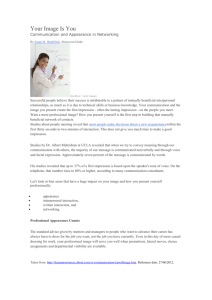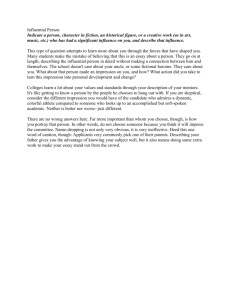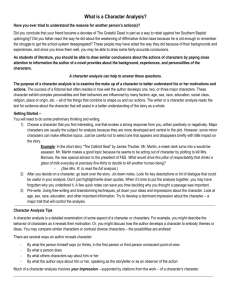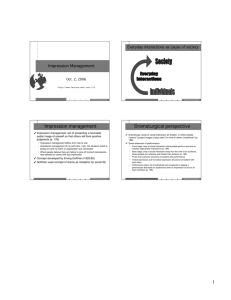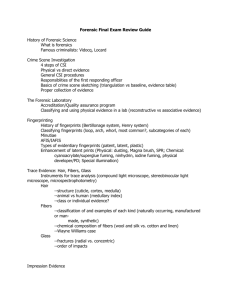Footwear Impressions
advertisement
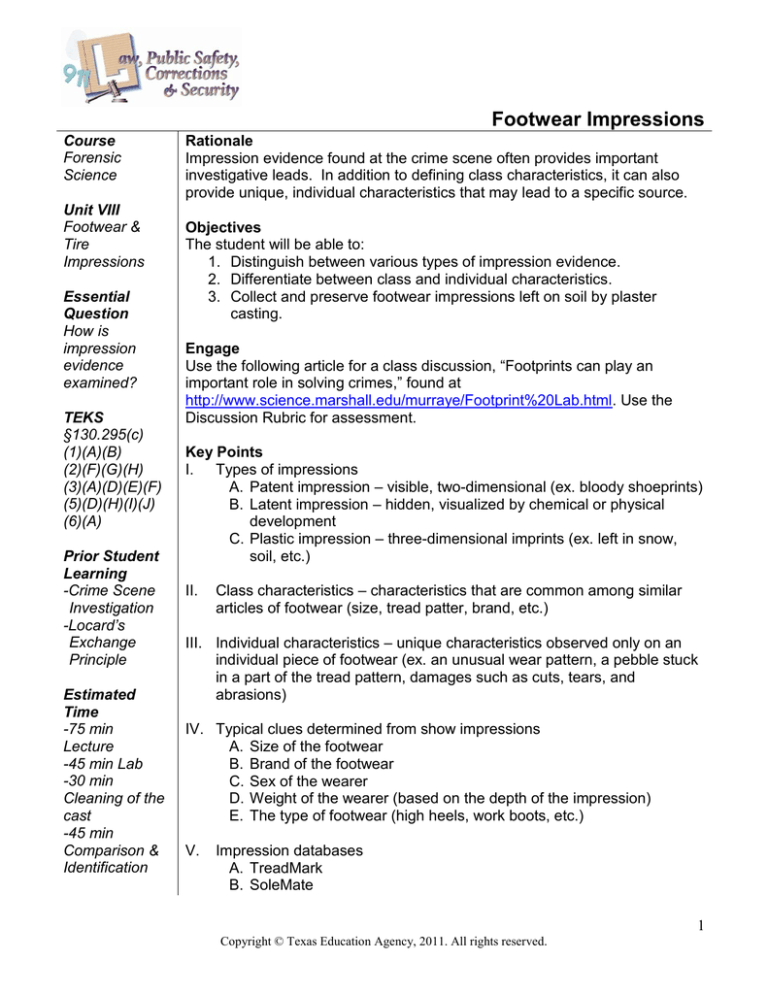
Footwear Impressions Course Forensic Science Unit VIII Footwear & Tire Impressions Essential Question How is impression evidence examined? TEKS §130.295(c) (1)(A)(B) (2)(F)(G)(H) (3)(A)(D)(E)(F) (5)(D)(H)(I)(J) (6)(A) Prior Student Learning -Crime Scene Investigation -Locard’s Exchange Principle Estimated Time -75 min Lecture -45 min Lab -30 min Cleaning of the cast -45 min Comparison & Identification Rationale Impression evidence found at the crime scene often provides important investigative leads. In addition to defining class characteristics, it can also provide unique, individual characteristics that may lead to a specific source. Objectives The student will be able to: 1. Distinguish between various types of impression evidence. 2. Differentiate between class and individual characteristics. 3. Collect and preserve footwear impressions left on soil by plaster casting. Engage Use the following article for a class discussion, “Footprints can play an important role in solving crimes,” found at http://www.science.marshall.edu/murraye/Footprint%20Lab.html. Use the Discussion Rubric for assessment. Key Points I. Types of impressions A. Patent impression – visible, two-dimensional (ex. bloody shoeprints) B. Latent impression – hidden, visualized by chemical or physical development C. Plastic impression – three-dimensional imprints (ex. left in snow, soil, etc.) II. Class characteristics – characteristics that are common among similar articles of footwear (size, tread patter, brand, etc.) III. Individual characteristics – unique characteristics observed only on an individual piece of footwear (ex. an unusual wear pattern, a pebble stuck in a part of the tread pattern, damages such as cuts, tears, and abrasions) IV. Typical clues determined from show impressions A. Size of the footwear B. Brand of the footwear C. Sex of the wearer D. Weight of the wearer (based on the depth of the impression) E. The type of footwear (high heels, work boots, etc.) V. Impression databases A. TreadMark B. SoleMate 1 Copyright © Texas Education Agency, 2011. All rights reserved. C. TreadMate VI. Factors affecting shoe wear patterns A. Walking habits (walking on toes or heels, feet straight or toes pointed in/out) B. Body weight C. Shape of the feet D. Activities often engaged in E. Surface walked on F. Unique debris, holes, cuts VII. Collection & preservation of impression evidence A. Photograph that includes a ruler B. Lifting with electrostatic dusting or gel lifting C. Casting with plaster of Paris (CaSO4) or dental stone (on snow) Activities 1. Complete the Footwear Impressions Lab (see materials below). 2. Footwear Impressions Comparison – Give each student another student’s shoe cast, made during the impressions lab. Give the students four (4) possible shoes with which to compare and identify the source of the unknown impression. Have the students give an oral or written detailed description of their basis for identification, including class characteristics and locations (size, dimensions, brand, model, tread patterns, and design), and individual characteristics and locations (materials stuck in the tread pattern, cut, tear, holes, etc.). Use the Writing Rubric for assessment. Assessments Footwear Impressions Lab Rubric Discussion Rubric Individual Work Rubric Writing Rubric Materials Footwear Impressions computer-based presentation Footwear Impressions Lab Packet The Forensic Analysis of Footwear Impression Evidence (pp. 121-131) http://www.fbi.gov/about-us/lab/handbook-of-forensic-services-pdf/ Resources Saferstein, Richard. Forensic Science: An Introduction. New Jersey: Pearson Prentice Hall, 2008. Bertino, Anthony J. Forensic Science: Fundamentals and Investigations. Mason, OH: South-Western Cengage Learning, 2009. Dr. Murray’s Footprint Lab 2 Copyright © Texas Education Agency, 2011. All rights reserved. http://science.marshall.edu/murraye/Footprint%20Lab.html Federal Bureau of Investigation http://www.fbi.gov/about-us/lab/handbook-of-forensic-services-pdf/ Accommodations for Learning Differences For reinforcement, the student will make an inked impression of his or her own footwear and identify the class and individual characteristics that are present. Use the Individual Work Rubric for assessment. For enrichment, the student will collect and preserve impression evidence using a dental stone. Use the Individual Work Rubric for assessment. State Education Standards Texas Essential Knowledge and Skills for Career and Technical Education §130.295. Forensic Science (One Credit). (1) The student, for at least 40% of instructional time, conducts laboratory and field investigations using safe, environmentally appropriate, and ethical practices. These investigations must involve actively obtaining and analyzing data with physical equipment, but may also involve experimentation in a simulated environment as well as field observations that extend beyond the classroom. The student is expected to: (A) demonstrate safe practices during laboratory and field investigations; and (B) demonstrate an understanding of the use and conservation of resources and the proper disposal or recycling of materials. (2) The student uses scientific methods and equipment during laboratory and field investigations. The student is expected to: (F) collect and organize qualitative and quantitative data and make measurements with accuracy and precision using tools such as calculators, spreadsheet software, data-collecting probes, computers, standard laboratory glassware, microscopes, various prepared slides, stereoscopes, metric rulers, electronic balances, gel electrophoresis apparatuses, micropipettors, hand lenses, Celsius thermometers, hot plates, lab notebooks or journals, timing devices, cameras, Petri dishes, lab incubators, meter sticks, and models, diagrams, or samples of biological specimens or structures; (G) analyze, evaluate, make inferences, and predict trends from data; (H) communicate valid conclusions supported by the data through methods such as lab reports, labeled drawings, graphic organizers, journals, summaries, oral reports, and technology-based reports. (3) The student uses critical thinking, scientific reasoning, and problem solving to make informed decisions within and outside the classroom. The student is expected to: (A) in all fields of science, analyze, evaluate, and critique scientific explanations by using empirical evidence, logical reasoning, and experimental and observational testing, including examining all sides of 3 Copyright © Texas Education Agency, 2011. All rights reserved. scientific evidence of those scientific explanations, so as to encourage critical thinking by the student; (D) evaluate the impact of scientific research on society and the environment; (E) evaluate models according to their limitations in representing biological objects or events; and (F) research and describe the history of science and contributions of scientists. (5) The student recognizes the procedures of evidence collection while maintaining the integrity of a crime scene. The student is expected to: (D) apply knowledge of the elements of criminal law that guide search and seizure of persons, property, and evidence; (H) demonstrate proper techniques for collecting and packaging physical evidence found at a crime scene; (I) explain the functions of national databases available to forensic scientists; and (J) collect and preserve physical evidence from a simulated crime scene. (6) The student analyzes the evidence collected from a crime scene using scientific methods. The student is expected to: (A) demonstrate conversions of measurements between English and International System (SI) of units; College and Career Readiness Standards Science Standards I. Nature of Science: Scientific Ways of Learning and Thinking A. Cognitive skills in science 2. Use creativity and insight to recognize and describe patterns in natural phenomena. 4. Rely on reproducible observations of empirical evidence when constructing, analyzing, and evaluating explanations of natural events and processes. 4 Copyright © Texas Education Agency, 2011. All rights reserved. Name:____ _____________________ Date:_______ ________________ Trace Evidence: Footwear Impressions Lab Objective: To collect and preserve a footwear impression by using plaster of Paris. Materials: 1 cardboard box 1 large plastic garbage bag 1 empty plastic cup Sand/soil 1 bag of plaster of Paris 1 can of aerosol hair spray (shared with others) 1 paint brush 1 paint stir stick 1 toothbrush Procedure: 1. 2. 3. 4. Line the cardboard box with the plastic garbage bag. Pour the sand or soil into the bottom of the cardboard box. Using your hand, smooth out the surface of the sand in the cardboard box. Step firmly into the sand. DO NOT rock your foot back and forth. Gently remove your foot from the sand by lifting straight up. View your impression. If it does not seem to be a good impression, smooth out the sand and repeat the process. 5. Hold the hairspray can 12 inches above the impression and spray. If you hold the can too close, the spray will destroy your impression. Spray the entire area of the impression, along with the inch of sand that surrounds the impression. (The sand will look wet.) 6. Fill the empty plastic cup halfway with tap water. 7. Slowly add the plaster of Paris to the water in the cup. DO NOT dump the plaster into the water all at once. Stir continuously as the plaster is being added to the water. 8. Stir until your plaster mixture has a smooth consistency, similar to pancake batter, and until the plaster is dissolved. DO NOT OVERSTIR, since this will cause your plaster to become too thick. 9. Hold the paint stirrer about 1 or 2 inches above the impression. Pour the plaster of Paris over the paint stirrer and onto the impression (this helps to keep the plaster from splashing and collapsing the impression detail). 10. If the impression is small, you will not need to use all of the plaster of Paris. Add enough plaster to cover the impression, but DO NOT overload the impression. 11. Discard the unused plaster in the garbage. DO NOT DUMP PLASTER OF PARIS DOWN THE SINK! 12. Gently smooth the top of the plaster of Paris with the paint stirring stick, distributing the plaster evenly over the impression. 13. Allow the cast to harden for at least 30 minutes. Lifting the cast too early will result in cracking. 5 Copyright © Texas Education Agency, 2011. All rights reserved. 14. Gently pry the cast up with your fingers along its edge. Turn it over. (It will most likely still be damp on the side closest to the sand.) 15. Gently brush away the sand with the paintbrush. 16. Use the toothbrush to remove any additional loose sand. 17. Allow the cast to air-dry. Questions: 1) Why do crime scene investigators build a frame around the shoe impression before casting? 2) What was the purpose of spraying the impression with the hair spray? 3) Why is it important to brush the excess sand from the plaster casting? 4) Shoe impressions can be obtained in the winter from snow, but plaster of Paris cannot be used. Why? 6 Copyright © Texas Education Agency, 2011. All rights reserved. Name:____ ____________________ Date:_______ __________________ Footwear Impressions Quiz Part I: Multiple Choices 1) A bloody shoe print is an example of a a. Patent impression b. Plastic impression c. Latent impression d. Composite impression . 2) A shoe impression left in snow is an example of a a. Patent impression b. Plastic impression c. Latent impression d. Composite impression 3) Which one of the following is considered to be an individual characteristic in footwear impression? a. Size b. Tread pattern c. Brand name d. Cut/tear 4) Which one of the following collection methods is suitable for collection and preservation of footwear impression in snow? a. Electrostatic dusting b. Gel lifting c. Plaster casting d. Dental stone casting 5) Which one of the following characteristics will provide the most individuality in a footwear impression comparison? a. A name brand tread pattern b. Severe wear in the heel area of the tread c. Limited production of a specific model d. A pebble stuck in the tread . Part II: Short Answers 6) What is plaster of Paris? 7 Copyright © Texas Education Agency, 2011. All rights reserved. 7) What is the most important element that must be present in forensic photography of footwear impressions? 8) What are the three (3) impression databases available in identification of footwear/tire impressions? 8 Copyright © Texas Education Agency, 2011. All rights reserved. Footwear Impressions Quiz Key 1) A 2) B 3) D 4) D 5) D 6) Calcium sulfate (CaSO4) used to make a cast of plastic impressions 7) A ruler (to allow for proper enlargement and reduction for 1:1 comparison of impressions) 8) TreadMark, SoleMate, TreadMate 9 Copyright © Texas Education Agency, 2011. All rights reserved. Name:_________________________ Date:___________________________ Trace Evidence: Footwear Impressions Lab Rubric Task steps Pts. Cast Cleanliness of the cast – the cast must be cleaned and free of dirt or soil, without scraping or brushing off important details. (20 pts.) Details preserved in the cast – should include cracks, materials stuck in the tread design, etc. (20 pts.) Overall structure – the cast must represent the entire piece of footwear. Missing portions or cracks compromise the integrity of the cast. (20 pts.) Correct Answers 1) To prevent any surrounding foreign objects from contaminating or damaging the impression, and to provide a mold for the cast so that the plaster liquid will not flow outside of the area of interest. (10 pts.) 2) To preserve the original shape and structure of the impression before the weight of the plaster or the environment (wind, soil, moisture) can alter it. (10 pts.) 3) Sand or soil left on the plaster cast can conceal and/or interfere with the details or individual characteristics being visualized by the examiner. It may also add some undesired characteristics that may not have been present in the original impression. (10 pts.) 4) Because the weight of plaster of Paris will crush and destroy the impressions on snow. Lighter casting material (such as dental stones) is preferred. (10 pts.) Total points possible 100 10 Copyright © Texas Education Agency, 2011. All rights reserved. Name_______________________________________ Date_______________________________ Discussion Rubric Objectives 4 pts. Excellent 3 pts. Good 2 pts. Needs Some Improvement 1 pt. Needs Much Improvement N/A Pts. Participates in group discussion Encourages others to join the conversation Keeps the discussion progressing to achieve goals Shares thoughts actively while offering helpful recommendations to others Gives credit to others for their ideas Respects the opinions of others Involves others by asking questions or requesting input Expresses thoughts and ideas clearly and effectively Total Points (32 pts.) Comments: 11 Copyright © Texas Education Agency, 2011. All rights reserved. Name______________________________________ Date_______________________________________ Individual Work Rubric 4 pts. Excellent Objectives 3 pts. Good 2 pts. Needs Some Improvement 1 pt. Needs Much Improvement N/A Pts. Follows directions Student completed the work as directed, following the directions given, in order and to the level of quality indicated Time management Student used time wisely and remained on task 100% of the time Organization Student kept notes and materials in a neat, legible, and organized manner. Information was readily retrieved Evidence of learning Student documented information in his or her own words and can accurately answer questions related to the information retrieved *Research/Gathering information (if relevant) Student used a variety of methods and sources to gather information. Student took notes while gathering information Total Points (20 pts.) Comments: 12 Copyright © Texas Education Agency, 2011. All rights reserved. Name:____________________________________ Date:_____________________________ Writing Rubric 4 pts. Excellent Objectives 3 pts. Good 2 pts. Needs Some Improvement 1 pt. Needs Much Improvement N/A Pts. The writing has all required parts from introduction to conclusion in smooth transition. The writing is interesting, supportive, and complete. The writing demonstrates that the writer comprehends the writing process. Accurate spelling, grammar, and punctuation The content of paragraphs emphasizes appropriate points. The writer shows an understanding of sentence structure, paragraphing, and punctuation. All sources and references are clearly and accurately documented. Total Points (28 pts.) Comments: 13 Copyright © Texas Education Agency, 2011. All rights reserved.
